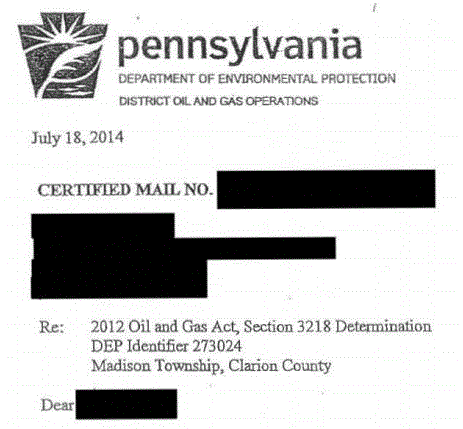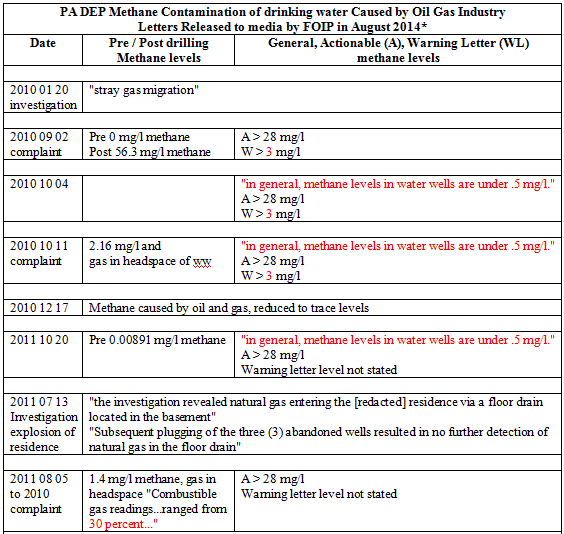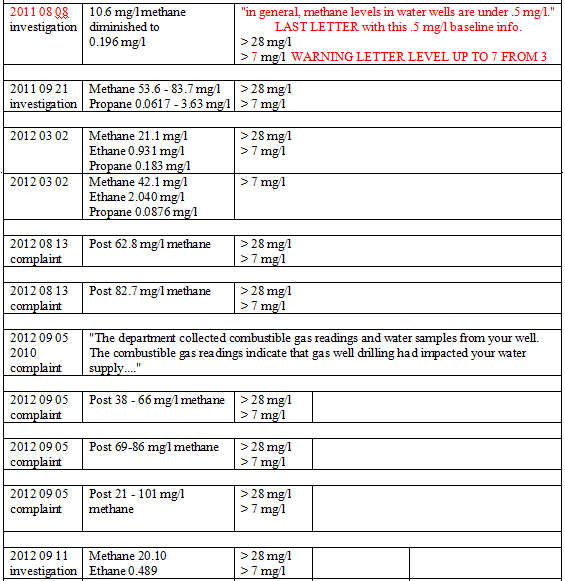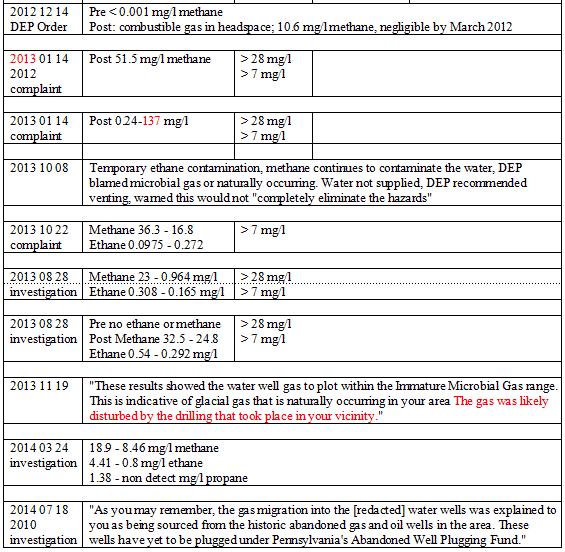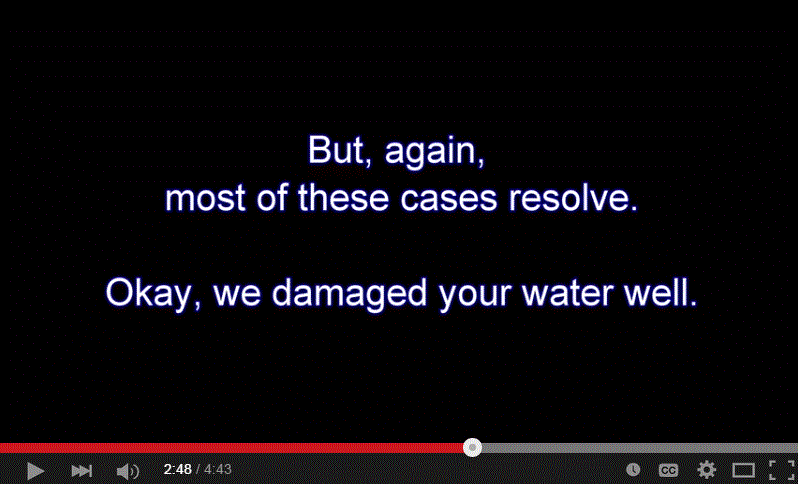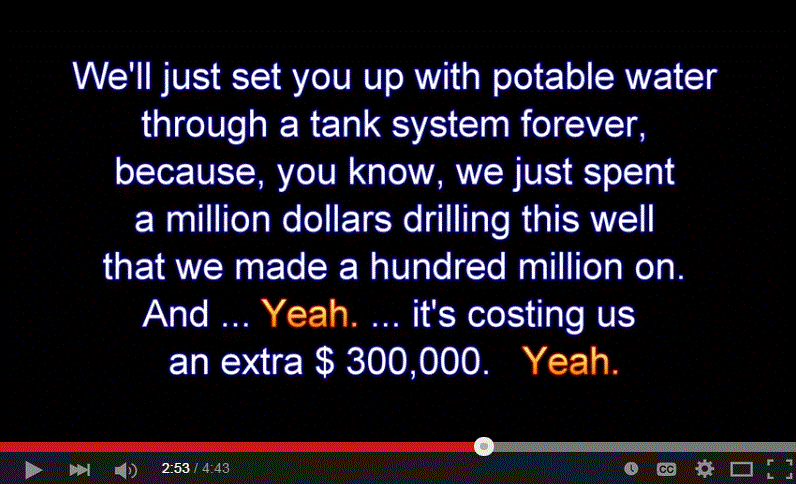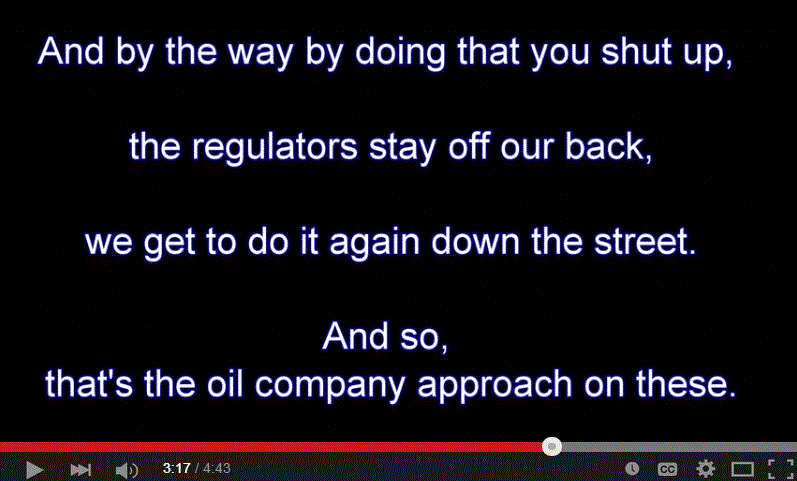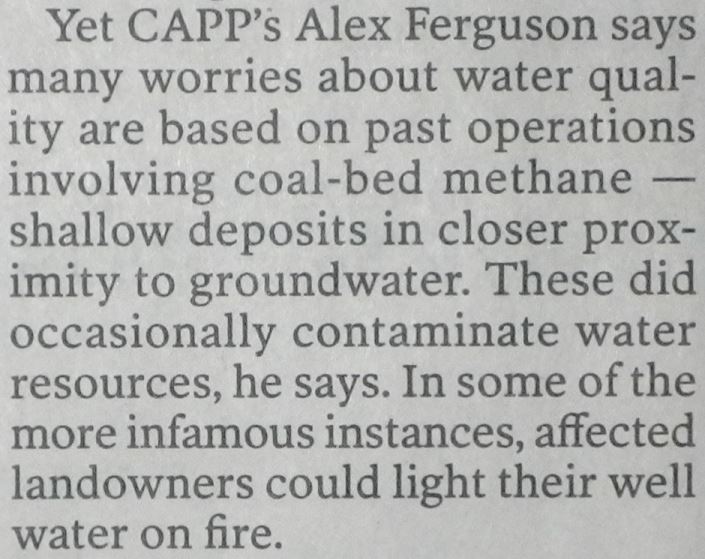Fracking Study on Water Contamination Under Ethics Review, Chesapeake Energy paid undisclosed fees to the lead author, whose study was based on water samples provided by the company by Neela Banerjee, April 6, 2015, InsideClimate News
Drinking-water wells in Pennsylvania close to natural gas sites do not face a greater risk of methane contamination than those farther away, according to a new study published in Environmental Science & Technology (ES&T). But the study is now being called into question because of its methodology and some undisclosed ties to energy giant Chesapeake Energy.
The findings contradict [the regulator (refer below) and] recent studies that identified a correlation between proximity to natural gas wells and higher methane levels in well water. The new study analyzed more than 11,000 water samples collected by Chesapeake and provided to researchers. [Lots of ways to intentionally collect methane samples that allow most of the methane to escape during sampling, and after]
Methane is the main component of natural gas and is not toxic for humans. But if the gas escapes from water taps and accumulates in confined spaces such as basements it poses a risk of explosion. [At more than 1 mg/l and can kill you by asphyxiation]
“We found no statistically [What’s the most abused and misused science in the world? Statistics] significant relationship between dissolved methane concentrations in groundwater from domestic water wells and proximity to pre-existing oil or gas wells,” wrote the authors, led by Donald Siegel, chairman of earth sciences at Syracuse University. “Previous analyses used small sample sets compared to the population of domestic wells available, which may explain the difference in prior findings compared to ours.”
Industry welcomed the Siegel study [That tells us all we need to know. Just like industry loved and welcomed the 2008 Alberta Research Council (now Alberta Innovates) reports by Dr. Alex Blyth dismissing the methane/ethane/propane/butane/sour gas/other red flag indicators of petroleum industry contamination (chromium, barium, strontium, petroleum distillates, phthalates, alcohol, and more) and suggesting water well owners to blame by way of E. coli], the largest ever evaluating methane in water near gas development, as evidence of the safety of hydraulic fracturing. The production method is driving the gas boom in Pennsylvania’s Marcellus Shale and across the country. [Driving a boom or theft and financial ruin hyped as a boom?]
But scientists not involved in the study reacted cautiously because of its methodology, in which Chesapeake sampled treated water and used a methane sampling method that major water labs don’t use.
Further, the study authors failed to divulge the scope of their ties to Chesapeake, including fees the company paid to Siegel to carry out his research. One of the paper’s four co-authors, Bert Smith, worked for Chesapeake during some of the period when the study took place, which also wasn’t disclosed. Smith works for the company today. The paper only acknowledges that Chesapeake provided the dataset.
After questions from InsideClimate News, a spokesman for ES&T said its editors would review whether their disclosure conformed to its ethics guidelines. The peer-reviewed journal requires a paper’s lead author to submit a statement that describes “all potential sources of bias, including affiliations, funding sources, and financial or management relationships, that may constitute conflicts of interest.”
Siegel said that he considered the disclosure on the paper adequate, and that his analysis was not influenced by Chesapeake. “I’ve done work for any number of environmental groups, and I’ve worked for industry,” he said. “I go where the science is. I have no hidden agenda here.” He declined to specify the fee amount he received, other than to say “I didn’t get rich.”
Chesapeake, the nation’s second-largest producer of natural gas, shared its water samples from northeastern Pennsylvania with Siegel about three years ago because he had gained a reputation among oil and gas companies as a fair researcher, he said. “I agreed to work on the project as long as I was unfettered in what I do and say,” Siegel said.
Chesapeake and Smith declined to comment. Siegel said Smith’s affiliation with Chesapeake was not revealed in the paper because Smith worked elsewhere for most of the time the analysis was being done.
Smith’s work history on LinkedIn changed over the last two weeks, showing conflicting accounts of his employment in the last two years. But a presentation of the methane paper at an October 2014 conference lists Smith as a Chesapeake employee. The paper, when it was received in November 2014 by ES&T, however, lists Smith as an employee of Enviro Clean, an Oklahoma-based environmental remediation company that is a Chesapeake contractor.
“This struck me as problematic. In general, it’s unusual for academics to not disclose external funding sources, especially on controversial topics such as fracking,” said Gretchen Goldman, lead analyst at the Union of Concerned Scientists’ Center for Science and Democracy. “We could argue it would have been good policy for him to mention that.”
Study Challenged
Siegel, a hydrogeologist with long experience in the Marcellus Shale, said isolated cases of methane contamination from gas development have occurred as fracking spread through the area. But he called fears of widespread water contamination overblown.
Siegel challenged, in particular, studies led by the influential former Duke University earth science professor Robert Jackson. Jackson’s teams found a correlation between proximity to gas development and elevated concentrations of methane in residential well water. His research, known as the “Duke studies,” has been widely cited and was used by New York officials in the decision to ban fracking, according to reports.
“They were going to places where they know a priori that there was a gas problem,” Siegel said of Jackson’s team. “You have to sample broadly and randomly to avoid bias.”
Jackson, who is now at Stanford University, disputed Siegel’s characterization of his studies. “Our goal is to understand the exceptions, the minority of cases where something went wrong; why it happened; and how can we keep it from happening somewhere else,” he said. Jackson said he offered to Chesapeake to help analyze its well data, but the company did not respond.
The Siegel study was based on water samples taken between June 2009 and November 2011 from homes within a three-quarter-mile radius of Chesapeake’s planned new gas wells. Because the region already had so much gas development, in many cases an operating well was already nearby, the paper said. In 75 percent of the cases, no methane was detected. [Easy to sample contaminated water and let methane escape. In the bogus water contamination investigations in Alberta, the regulator proved itself an expert at it. Also, if water wells were not purged adequately, the samplers are assured of not getting representative methane concentrations from the aquifers, which Alberta Environment proved itself also expert at] The rest showed some methane but no relationship to gas well proximity. The Chesapeake samples were gathered a few months before drilling; they didn’t track the wells over time to see if changes occurred.
Amy Townsend-Small, a geology professor at the University of Cincinnati, said she welcomes the bigger data set that Chesapeake provided. But she challenged suggestions that the new paper refutes Jackson’s studies. She said Jackson’s team tried to home in on the origins of the methane they detected in well water. Industry has argued that methane in well water originated in microbial sources rather than Marcellus gas and was present before fracking began. [Same blame nature game as everywhere water is methane contaminated by the oil and gas industry, conventional or unconventional]
A 2013 Duke study of 141 water wells in northeastern Pennsylvania found 82 percent contained methane. Contaminated wells within about a half a mile of an active gas well had concentrations of methane six times higher than those farther away.
The scientists looked at the ratio of noble gases such as helium to methane in contaminated water. They also looked at the levels of ethane and propane in methane-tainted water. Particular ratios of helium to methane and certain levels of ethane and propane in contaminated water indicated that some methane was from a deep geological source, such as the Marcellus Shale. The isotopic fingerprint of the methane was also similar to that of Marcellus gas.
The studies suggested the Marcellus methane ended up in well water because of the wells’ faulty metal casings that allowed the methane to seep out into aquifers as natural gas was pumped to the surface. The research said the leaks could also be linked to poor concrete construction inside gas wells.
“We’ve worked hard to develop additional tools that complement the methane sampling,” Jackson said in an email. “For example, the [Siegel] paper doesn’t acknowledge or discuss ethane or noble gases. Why not?”
Jackson also challenged the study’s water collection methods. Chesapeake hired contractors to sample the water at the tap. As a result, some of the water had already undergone treatment on its way from well to faucet. Treatment and running the water adds “noise” to the readings and affects the amount of methane in a sample, Jackson said.
Further, the contractors used the so-called inverted bottle method to collect the samples, which entails placing an upside-down bottle in a bucket of water to collect the escaping gas. Jackson said he does not use the inverted bottle method because it doesn’t produce reliable results. The United States Geological Survey and some other major water testing labs do not use the technique to measure methane.
Siegel said the testing protocol followed Pennsylvania regulatory guidelines. He said that testing water at the tap would not lead to substantially lower readings of methane.
Chesapeake’s data would yield new papers in the coming months, Siegel said.
[Refer also to:
1996 Canadian Association of Petroleum Producers Methane Migrating from Leaking Energy Wells Report: 1 mg/l methane dissolved in water poses risk of explosion
“there may be risk of an explosion, if the water supplies pass through poorly ventilated air spaces”
CAPP reported dramatically increased levels of methane in groundwater near leaking hydrocarbon wells.
Slides above and below from Ernst speakng events
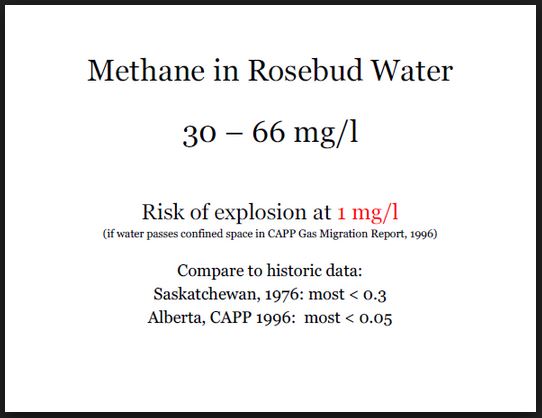
SUMMARY TABLE OF KEY INFORMATION IN PENNSYLVANIA DEP’S WARNING LETTERS TO WATER WELL OWNERS WITH WATER AND HOMES CONTAMINATED BY INDUSTRY’S MIGRATING METHANE:
*Many more letters were released showing other contamination, all were caused by oil gas activities. Only gas contamination letters are tabled. If no methane data is listed, none was presented in the letter. PDF of the above table
July 2014, DEP released 209 cases since late 2007; August 28, 2014 they released more cases, bringing total to 248 cases. Media FOIPed for and released the letters.
Standard comment in most of the DEP methane home and water contamination letters:
“There is a physical danger of fire or explosion due to the migration of natural gas into water wells or through soils into dwellings where it could be ignited by sources that are present in most homes/buildings. Natural gas migration can also cause threat of asphyxiation….
It is the Department’s recommendation that all water wells should be equipped with a working vent. This will help alleviate the possibility of concentrating these gases in areas where ignition would pose a threat to life or property. Please note that it is not possible to completely eliminate the hazards of having natural gas in your water supply by simply venting your well.”
The Complete List of PA DEP Letters (includes links to the (redacted) reports, which name companies)
2013 09: Alberta Energy Regulator lawyer Glenn Solomon giving legal advice to a family with water well contamination from fracing
Yet CAPP’s Alex Ferguson says many worries about water quality are based on past operations involving coal-bed methane — shallow deposits in closer proximity to groundwater. These did occasionally contaminate water resources, he says. In some of the more infamous instances, affected landowners could light their well water on fire.
“That’s actually fairly common.” EnCana VP, Mr. Gerard Protti (appointed Chair of the AER by the government in 2013) in a 2006 interview about Ernst’s water.
Alex Ferguson was appointed Commissioner and CEO of the BC Oil and Gas Commission from 2007-2011
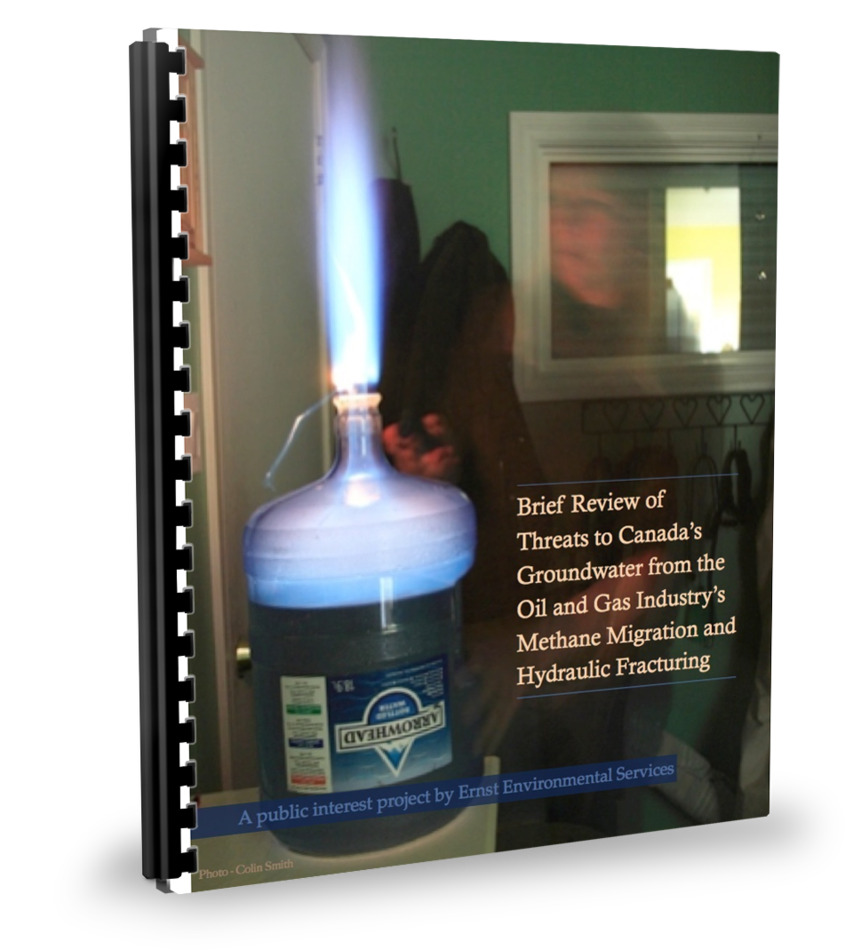 FrackingCanada The Science is Deafening Industry’s Gas Migration
FrackingCanada The Science is Deafening Industry’s Gas Migration
Ohio Valley Energy purchased the home of Mr. and Mrs. Payne where the explosion took place….

Bruce Jack Private water well explosion at Spirit River, Alberta Alberta Hansard, May 17, 2006
Dr. Swann: Three years this man waited for investigations. He still has no explanation of why his water exploded. Mr. Speaker, the Minister of Environment has not met the mark in protecting our most vital resource.
The Speaker: Hon. member, I appreciate that there’s a synergy that goes on in here, and I also appreciate that there’s emotion, but it’s question period. Let’s get to the question
“Disgust with AB Research Council Report goes beyond Alberta” published as “The Stelmach two-step”
In April 2012, after Ernst paying $4,150 dollars, 1.5 years in official inquiry by the OIP Commissioner’s Office and giving up thousands of hours over four years trying to get the public baseline testing data used by Dr. Blyth (as of August 31, 2014 still withheld) and records used/related to his reports under Freedom of Information Legislation, ARC finally releases to Ernst that Alberta Environment (the regulator the ARC was “reviewing”) secretly edited Blyth’s “independent” reports:
The released records also revealed that Alberta Environment edited Dr. Blyth’s publicly released “Independent” Summary Report of the four water contamination investigations by Alberta Environment (on the Zimmerma, Signer, Lauridsen and Ernst water wells).
Dr. Blyth’s CV, Proposal and Terms of Reference agreed to with Alberta Environment are included:
A few key quotes:
The purpose of the Summary Report is to inform the general public about the findings of the ARC scientific reviews and to increase public confidence in the AENV complaint investigation process.
[Shouldn’t the purpose be to find out what happened to the water to contaminate it, what companies did with their hydraulic fracturing and where, and if the companies were compliant with Alberta laws and regulations etc?]
The Summary Report is to be written in a manner that is…. Clearly understood by the general public (aim for Grade 8 education level) [Emphasis added]




